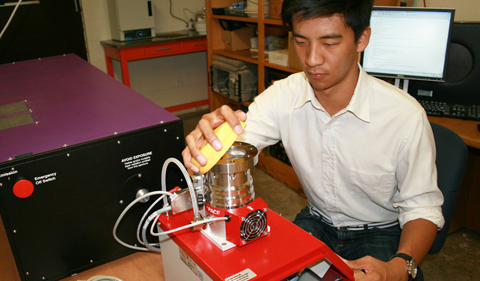By Jean Andrews
Physics & Astronomy
Why Be an Undergraduate Summer Intern?
“To learn by experience!” – Samantha Thrush
“I created my first successful nanostructure!” – Chris Wolfe
“It allowed me to do something that may help advance our scientific knowledge.” – Ryan Goetz
What Are Some Recent Intern Experiences?
In summer 2014, 21 majors participated in internships administered through the Department of Physics & Astronomy’s undergraduate summer research program. The interns were supervised by 12 department faculty members in research labs on projects ranging in scale from measuring atomic nuclei, to observing cancer cell properties, to galaxy cluster simulations.
Some summer research included travel to locations in Colorado, Minnesota, Virginia, as well as Italy and France. Undergraduate research offers life-changing opportunities to dig deeper into the mysteries of the universe and to enjoy the journey to discover how things work.
“Our faculty have the strong record of federal funding needed to support our Ph.D. program, so we’ve been able to offer up to 20 paid summer research projects per year for interested undergraduate students,” explained Dr. David Tees, Associate Professor of Physics at Ohio University, and the undergraduate adviser. “More than 75 percent of our graduating undergrads have done research internships with faculty during their time at Ohio University,” he continued.
The research projects give students hands-on experience with research equipment and analysis techniques and a chance to interact with a faculty mentor and his or her graduate students. This experience inspires students to excel in their courses and helps them to identify career options in industry or academia, including topic areas that they might want to work on for a Ph.D., or that they don’t want to work on for a Ph.D.
“From a student’s perspective, it’s an opportunity to work closely with a faculty member, which is useful when looking for letters of recommendation for graduate school and employment. From the point of view of our faculty members, it’s a chance for an enthusiastic extra pair of hands for analyzing and collecting data, or for developing the expertise needed to bring a new technology or technique to the lab,” Tees said.
In Their Own Words and Pictures
Peter Andrews “The Relationship Between Annealing Temperature and Size of Nuclei in Phase Change Memory Materials”
Max Camp “Data Analysis in the Search for the Pentaquark”
Alex Carroll “Re-evaluating the Thermonuclear Reaction Rate for the 18F(p,alpha)15O Reaction”
Helen Cothrel “Summertime Ozone Measurements in the Colorado Front Range”
Justin Courtright “Making with Microcontrollers”
Ryan Goetz “Improving Cluster Mass Measurement Techniques with Cosmological Simulations”
Miguel Gomez “The Pion Cloud and Motion of Sub-Atomic Particles”
Erin Grimes “Building an Optics Model to Examine Works of Art and Nature”
Taylor Grueser “A Calorimetric Study of the Metal Induced Crystallization of Amorphous Silicon”
Jacob Hartman “Video Microscopic Analysis for Determination of Cancer Cell Mechanical Properties”
Kylie Holmes “Detecting More Pion”
Hunter Lawson “Sputter Epitaxy of LaMnO3 on SrTiO3”
Miles Lindquist “Simulating a Realistic GRETINA”
David Overton “Determining the Feasibility of Measurements of the 19F(p,n)19Ne* Reaction”
Robert Radloff “Detecting Photons Another Way”
Thomas ‘Tad’ Riley “Getting to Know the Atomic Force Microscope and Its Uses”
Sara Sand “Building Stirling Engines”
Samantha Thrush “Welcome to LIGO, a World-Class Observatory”
Chris Wolfe “Developing a Photolithography Procedure to Produce Micron Scale Metallic Devices”
Yonry Zhu “Assembling a Pulsed Laser Deposition System to Allow for Tandem MBE/PLD Sample Synthesis”




















Comments